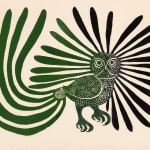KENOJUAK ASHEVAK, C.C., R.C.A. (1927-2013) KINNGAIT (CAPE DORSET)
Printer: IYOLA KINGWATSIAK (1933-2000) KINNGAIT (CAPE DORSET)
stonecut, 22.75 x 26 in (57.8 x 66 cm)* framed
36/50
ESTIMATE: $40,000 — $60,000
PRICE REALIZED: $138,000.00
A world record for a "green-tail" version at auction.
Further images
Kenojuak was born to be an artist. She made and played with paper cutouts already as a young girl, and in the early 1950s made patterns to use in her sewing of clothing, dolls, and sealskin bags, including the one that inspired her first print Rabbit Eating Seaweed. Although she was given paper and pencils during her stay at the Parc Savard Hospital in Québec City (1952-55), there is no record of drawings by her from this time. Alma Houston gave Kenojuak drawing paper in 1957 or 1958, and she finally took up drawing seriously by 1959.
Kenojuak beautifully describes how she approaches putting pencil to paper in a 1980 interview with Jean Blodgett; she begins with a “statement” and adds elements slowly, carefully assessing things and sensing when to stop before it’s too late. "... [A]nd the thing just sort of fills in to a certain point at which, to my eye, that’s it. There’s really no place to put anything else that would be part of the solution any more, and so then I stop" [1]. She makes it sound so easy!
The lyrical “silhouette” style of Kenojuak’s famous first print Rabbit Eating Seaweed can be seen in several of her drawings and prints from the very early 1960s (see Lots 8 and 57), but she was clearly eager to experiment with other imagery. Kenojuak’s most famous work, The Enchanted Owl, is notable for the clarity and boldness of its single, central image. This is not a dreamy, meandering creation but a striking and confident visual statement. It must have knocked people’s socks off when it was released, and it retains its thoroughly modern graphic punch even today. The Enchanted Owl became the most famous image in Inuit art; instantly recognizable, it has achieved truly iconic status. Reproduced on a 1970 Canadian postage stamp, it has graced the covers of several important books and has been illustrated in Inuit art and other books countless times.
In his exhibition catalogue Inuit Prints: Japanese Inspiration (2011), Norman Vorano notes how Japanese kappazuri prints, with their apparently free-form movement of colours across the images, influenced Inuit printmakers: “the first Cape Dorset stonecut in which colours are seen to be similarly unmoored from their form-defining duty is the well-known 1960 print by Kenojuak Ashevak, The Enchanted Owl [...]. Here, the printmakers treated the print block like a palette on which they rolled multiple colours without adhering to contours of the material support” (p. 57).
As with another of Kenojuak’s iconic prints from 1960, The Woman Who Lives in the Sun, this image was printed in two different colours: the first 25 copies in red and black, and the next 25 in green and black (they are often referred to as “red-tail” and “green-tail”). The red and green versions of this print differ, and each is strikingly beautiful, but importantly every print in each of the two sets is quite different from any other. This results from the intensity of the ink colours applied, and from their degree of overlap (dependent on the reach of the rollers) and the intensity relative to each other.
In this stunning example, all three elements combine to create the perfect alchemy. The master printmaker Eegyvudluk applied a particularly rich dark green that overlaps and blends beautifully with the deep black. Splendid.
1. Blodgett, Kenojuak, 1985, p. 38.
References: Norman Vorano, Inuit Prints: Japanese Inspiration, (Gatineau: Canadian Museum of Civilization, 2011), p. 57. For more information on this famous artist see Jean Blodgett, Kenojuak, (Toronto: Firefly Books / Mintmark Press Ltd., 1985); Anna Hudson, Jocelyn Piirainen, & Georgiana Uhlyarik, Tunirrusiangit: Kenojuak Ashevak and Tim Pitsiulak, exh. cat., (Toronto: Art Gallery of Ontario, 2018); Odette Leroux ed., Inuit Women Artists (Vancouver: Douglas & McIntyre / Gatineau: Canadian Museum of Civilization, 1994).
*Note: There is a typographical error in the catalogue. The actual dimensions of the sheet are 22.75 x26 in. While many early Kinngait stonecuts were printed on whatever sheets of paper were on hand and the concepts of uniformity and standardization did not take hold until the early 1960s, the possibility exists that this particular example might have been trimmed. It is our opinion however that the glorious inking of this print more than offsets any possible paper loss.
Provenance
Ex Collection of Dorothy Eber, C.M.;Galerie Elca London, Montreal;
Collection of John and Joyce Price, Seattle.
Exhibitions
Toronto, Art Gallery of Ontario, Uhlyarik, Tunirrusiangit: Kenojuak Ashevak and Tim Pitsiulak, exh. cat., 2018, their label affixed to the frame verso, EXH.141628.Join our mailing list
* denotes required fields
We will process the personal data you have supplied in accordance with our privacy policy (available on request). You can unsubscribe or change your preferences at any time by clicking the link in our emails.






